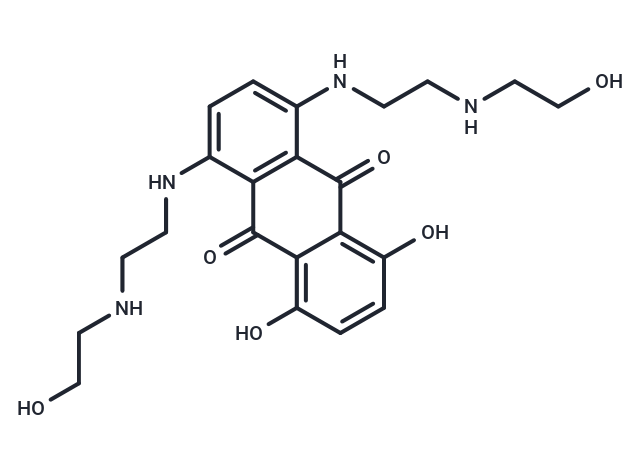Shopping Cart
- Remove All
 Your shopping cart is currently empty
Your shopping cart is currently empty

Mitoxantrone (mitozantrone) is an anthracenedione antibiotic with antineoplastic activity. Mitoxantrone intercalates into and crosslinks DNA, thereby disrupting DNA and RNA replication. This agent also binds to topoisomerase II, resulting in DNA strand breaks and inhibition of DNA repair. Mitoxantrone is less cardiotoxic compared to doxorubicin.

| Pack Size | Price | Availability | Quantity |
|---|---|---|---|
| 25 mg | $33 | In Stock | |
| 50 mg | $47 | In Stock | |
| 100 mg | $65 | In Stock | |
| 200 mg | $109 | In Stock | |
| 1 mL x 10 mM (in DMSO) | $50 | In Stock |
| Description | Mitoxantrone (mitozantrone) is an anthracenedione antibiotic with antineoplastic activity. Mitoxantrone intercalates into and crosslinks DNA, thereby disrupting DNA and RNA replication. This agent also binds to topoisomerase II, resulting in DNA strand breaks and inhibition of DNA repair. Mitoxantrone is less cardiotoxic compared to doxorubicin. |
| Targets&IC50 | PKC:8.5 μM. |
| In vitro | Mitoxantrone induces DNA fragmentation and the proteolytic cleavage of poly(ADP-ribose) polymerase (PARP), a marker of the activation of caspases, in all the patients studied, demonstrating that the cytotoxic effect of mitoxantrone is due to induction of apoptosis. [1] Mitoxantrone activates NFkappaB and stimulates IkappaBalpha degradation in the promyelocytic leukemia cell line HL60 but not in the variant cells, HL60/MX2 cells, which lack the beta isoform of topoisomerase II and express a truncated alpha isoform that results in an altered subcellular distribution. [2] Mitoxantrone inhibits proliferation of activated PBMCs, B lymphocytes, or antigen-specific T-cell lines (TCLs) stimulated on antigen-presenting cells (APCs) in a dose-dependent manner. Mitoxantrone induces apoptosis of PBMCs, monocytes and DCs at low concentrations, whereas higher doses causes cell lysis. [3] |
| In vivo | Mitoxantrone transiently decreases the growth rate of HID xenografts in mice but does not affect that of PAC120 xenografts. [4] Mitoxantrone results in the severity of the cardiac lesions and the nephropathy and the intestinal toxicity in spontaneously hypertensive rats. Mitoxantrone and iron(III) form a strong 2:1 complex, in which mitoxantrone may be acting as a tridentate ligand. [5] |
| Kinase Assay | activity-based protein profiling (ABPP): Mouse brains are Dounce-homogenized in PBS, pH7.5, followed by a low-speed spin (1,400×, 5 min) to remove debris. The supernatant is then subjected to centrifugation (64,000×, 45 min) to provide the cytosolic fraction in the supernatant and the membrane fraction as a pellet. The pellet is washed and resuspended in PBS buffer by sonication. Total protein concentration in each fraction is determined using a protein assay kit. Samples are stored at -80 °C until use. Mouse brain membrane proteomes, are diluted to 1 mg/mL in PBS and pre-incubated with varying concentrations of inhibitors (1 nM to 10 mM) for 30 min at 37 °C before the addition of FP-rhodamine at a final concentration of 2 mM in a 50 mL total reaction volume. After 30 min at 25 °C, the reactions are quenched with 4×SDS-PAGE loading buffer, boiled for 5 min at 90 °C, subjected to SDS-PAGE and visualized in-gel using a flatbed fluorescence s |
| Cell Research | The human breast carcinoma cell lines MDA-MB-231 and MCF-7 are seeded in standard 96-well plates. One day after seeding, the culture medium is changed and replaced by medium containing different concentration of Mitoxantrone (10-5 to 5 μM) with or without DHA (30 μM) during 7 days. Viability of cells are measured as a whole by the tetrazolium salt assay[3]. |
| Alias | mitozantrone |
| Molecular Weight | 444.48 |
| Formula | C22H28N4O6 |
| Cas No. | 65271-80-9 |
| Smiles | OCCNCCNc1ccc(NCCNCCO)c2C(=O)c3c(O)ccc(O)c3C(=O)c12 |
| Relative Density. | 1.45 g/cm3 |
| Storage | keep away from direct sunlight,store at low temperature,keep away from moisture | Powder: -20°C for 3 years | In solvent: -80°C for 1 year | Shipping with blue ice. |
| Solubility Information | 5% DMSO+95% Saline: 2.37 mg/mL (5.33 mM), In vivo: Please add the solvents sequentially, clarifying the solution as much as possible before adding the next one. Dissolve by heating and/or sonication if necessary. Working solution is recommended to be prepared and used immediately. Ethanol: < 1 mg/mL (insoluble or slightly soluble) DMSO: 88 mg/mL (197.98 mM), Sonication is recommended. H2O: < 1 mg/mL (insoluble or slightly soluble) 10% DMSO+40% PEG300+5% Tween 80+45% Saline: 0.15 mg/mL (0.34 mM), In vivo: Please add the solvents sequentially, clarifying the solution as much as possible before adding the next one. Dissolve by heating and/or sonication if necessary. Working solution is recommended to be prepared and used immediately. |

Copyright © 2015-2025 TargetMol Chemicals Inc. All Rights Reserved.